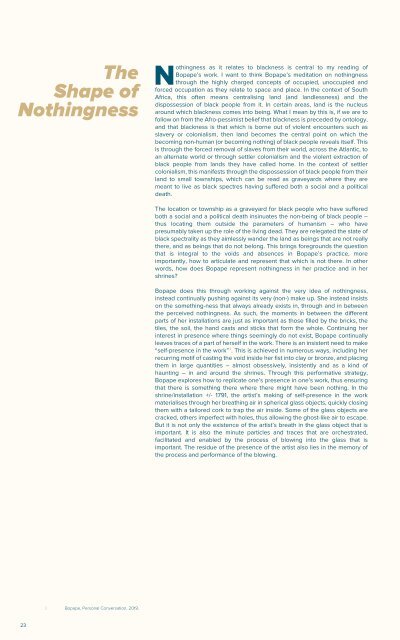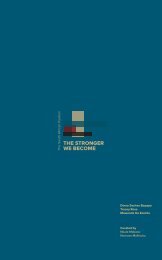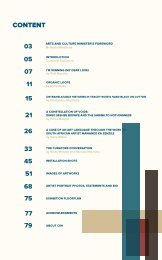The-Stronger-We-Become-Catalogue
Create successful ePaper yourself
Turn your PDF publications into a flip-book with our unique Google optimized e-Paper software.
<strong>The</strong><br />
Shape of<br />
Nothingness<br />
Nothingness as it relates to blackness is central to my reading of<br />
Bopape’s work. I want to think Bopape’s meditation on nothingness<br />
through the highly charged concepts of occupied, unoccupied and<br />
forced occupation as they relate to space and place. In the context of South<br />
Africa, this often means centralising land (and landlessness) and the<br />
dispossession of black people from it. In certain areas, land is the nucleus<br />
around which blackness comes into being. What I mean by this is, if we are to<br />
follow on from the Afro-pessimist belief that blackness is preceded by ontology,<br />
and that blackness is that which is borne out of violent encounters such as<br />
slavery or colonialism, then land becomes the central point on which the<br />
becoming non-human (or becoming nothing) of black people reveals itself. This<br />
is through the forced removal of slaves from their world, across the Atlantic, to<br />
an alternate world or through settler colonialism and the violent extraction of<br />
black people from lands they have called home. In the context of settler<br />
colonialism, this manifests through the dispossession of black people from their<br />
land to small townships, which can be read as graveyards where they are<br />
meant to live as black spectres having suffered both a social and a political<br />
death.<br />
<strong>The</strong> location or township as a graveyard for black people who have suffered<br />
both a social and a political death insinuates the non-being of black people –<br />
thus locating them outside the parameters of humanism – who have<br />
presumably taken up the role of the living dead. <strong>The</strong>y are relegated the state of<br />
black spectrality as they aimlessly wander the land as beings that are not really<br />
there, and as beings that do not belong. This brings foregrounds the question<br />
that is integral to the voids and absences in Bopape’s practice, more<br />
importantly, how to articulate and represent that which is not there. In other<br />
words, how does Bopape represent nothingness in her practice and in her<br />
shrines?<br />
Bopape does this through working against the very idea of nothingness,<br />
instead continually pushing against its very (non-) make up. She instead insists<br />
on the something-ness that always already exists in, through and in between<br />
the perceived nothingness. As such, the moments in between the different<br />
parts of her installations are just as important as those filled by the bricks, the<br />
tiles, the soil, the hand casts and sticks that form the whole. Continuing her<br />
interest in presence where things seemingly do not exist, Bopape continually<br />
leaves traces of a part of herself in the work. <strong>The</strong>re is an insistent need to make<br />
“self-presence in the work”³. This is achieved in numerous ways, including her<br />
recurring motif of casting the void inside her fist into clay or bronze, and placing<br />
them in large quantities – almost obsessively, insistently and as a kind of<br />
haunting – in and around the shrines. Through this performative strategy,<br />
Bopape explores how to replicate one’s presence in one’s work, thus ensuring<br />
that there is something there where there might have been nothing. In the<br />
shrine/installation +/- 1791, the artist’s making of self-presence in the work<br />
materialises through her breathing air in spherical glass objects, quickly closing<br />
them with a tailored cork to trap the air inside. Some of the glass objects are<br />
cracked, others imperfect with holes, thus allowing the ghost-like air to escape.<br />
But it is not only the existence of the artist’s breath in the glass object that is<br />
important. It is also the minute particles and traces that are orchestrated,<br />
facilitated and enabled by the process of blowing into the glass that is<br />
important. <strong>The</strong> residue of the presence of the artist also lies in the memory of<br />
the process and performance of the blowing.<br />
3 Bopape, Personal Conversation, 2019.<br />
23




